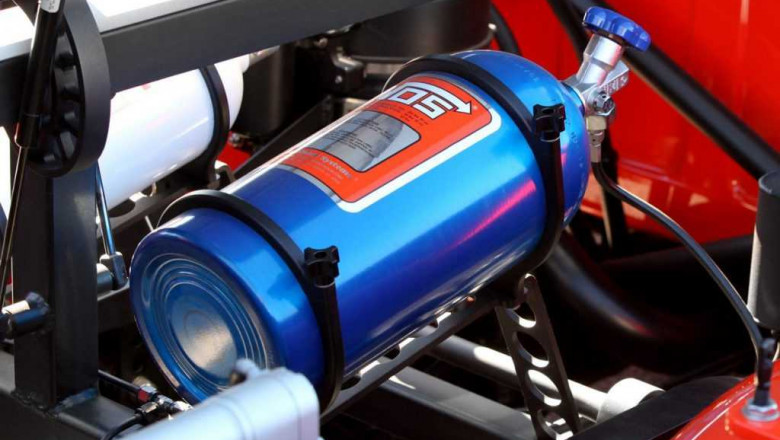views
What is Nitrous Oxide?
Nitrous oxide, commonly known as laughing gas or hippy crack, is a chemical compound with the formula N2O. At room temperature, it is a colorless non-flammable gas, with a slightly sweet odor and taste. Nitrous oxide has been used medically and recreationally for its dissociative anesthetic and euphoric effects.
Physical and Chemical Properties
Some key physical and chemical properties of nitrous oxide include:
- Molecular formula - N2O
- Molar mass - 44.01 g/mol
- Melting point - -90.8°C
- Boiling point - -88.5°C
- Density - 1.977 g/L (gas), 1.536 g/mL (liquid)
- Solubility in water - Slightly soluble
- Vapor pressure - 5395 kPa at 20°C
- Stable at room temperature but decomposes above 350°C to nitrogen and oxygen gases.
Nitrous Oxide is non-flammable but supports combustion by releasing oxygen. It is much less soluble in lipid solutions than nitric oxide, making it a physically less potent anaesthetic. However, its euphoric qualities have led to its recreational use.
Medical and Dental Uses
Nitrous oxide has been used medically as a general anaesthetic since the 1800s. Some common medical and dental uses of nitrous oxide include:
- Pain management during childbirth - Nitrous oxide is commonly used during labor and delivery to help reduce pain. When inhaled, it provides analgesia without much impairment of protective airway reflexes.
- Dental procedures - As a dental anesthetic, it is self-administered by the patient and delivers rapid onset of anxiolysis and analgesia with minimal equipment requirements. This makes it useful for short painful procedures.
- Minor surgical procedures - For brief surgical procedures like manual reduction of fractures or dressing changes, nitrous oxide provides short-term anesthesia when other options are unavailable.
- Treatment of anxiety and depression - Low doses of nitrous oxide may help reduce anxiety and distress in anxious patients and those with treatment-resistant depression.
- Wound debridement - The analgesic properties of nitrous oxide allow for the debridement of traumatic wounds and burns without more invasive anesthesia.
Recreational Use
Nitrous oxide has gained popularity as a recreational drug due to its euphoric and dissociative effects. Some ways it is misused recreationally include:
- Inhalation from whipped cream canisters - Nitrous oxide chargers or whippets that are used to aerate whipped cream are often inhaled for intoxication.
- Ballooning - The gas is inflated into a balloon from which it is inhaled to produce psychedelic effects.
- Creaming - Inhaling nitrous oxide directly from pressurized cartridges or whipped cream dispensers.
- Festivals/raves - Nitrous oxide is commonly used by young people at dance parties and music festivals for its brief euphoric effects.
While short-term use poses relatively low risks, regular recreational abuse can lead to vitamin B12 deficiency, nerve damage, and disturbances to nerve cell growth in the spinal cord.
Environmental Effects and Regulations
As a powerful greenhouse gas with 310 times more heat-trapping capacity than CO2, nitrous oxide has significant environmental impacts. Some relevant facts:
- Agricultural soil management contributes over 60% of global N2O emissions through nitrification and denitrification processes.
- It is estimated to be the third largest contributor to global warming after CO2 and methane, accounting for around 6% of the total radiative forcing from long-lived greenhouse gases.
- The Kyoto Protocol recognises N2O as one of the six greenhouse gases targeted for reduction commitments from national governments.
- Many countries restrict the sale and use of nitrous oxide cylinders for medical/dental purposes to prevent non-medicinal recreational abuse and emissions. Proper disposal is advised.
- Low-emission farming practices can help reduce agricultural N2O emissions and mitigate associated climate change risks.
nitrous oxide is an industrially useful gas with applications across medicine, dentistry, food production and many other sectors. However, uncontrolled emissions and recreational misuse underline the need for prudent regulations to curb both its environmental footprint and health risks.
Get this Report in Japanese Language:
Get this Report in Korean Language:
About Author:
Money Singh is a seasoned content writer with over four years of experience in the market research sector. Her expertise spans various industries, including food and beverages, biotechnology, chemical and materials, defense and aerospace, consumer goods, etc. (https://www.linkedin.com/in/money-singh-590844163)






















Comments
0 comment